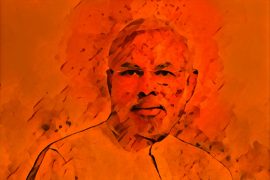Since the advent of the Industrial Revolution, human civilisations have adopted a capitalist model of economic growth that entrenched consumerism and warranted a linear chain of activities that follow a ‘take-make-dispose’ pattern. Such a consumer-led economy, which hinges on materialism, accelerates the depletion of natural resources at an alarming scale.
The linear process — extraction, production and disposal — perpetuates environmental degradation, climate change, and biodiversity loss and threatens the existence of our species. Ergo, traditional economic theory based on finite resources, scarcity, and optimum choice requires a quantum rethink as it is no longer a sustainable model for long-term economic growth and prosperity.
To address this issue, it is essential to follow natural systems that exhibit a circular flow. Instead of choosing a linear path of resource extraction, consumption and disposal, we must switch to a circular economy. A ‘Circular Economy’ — according to the Ellen MacArthur Foundation — is a function of three interdependent variables:
- Elimination of waste and pollution
- Circulation of products and materials
- Regeneration of nature
In a capitalist economy, waste management falls at the end of the pipeline. Products are designed such that they end up in a landfill or an incinerator; in the worst-case scenario, they are dumped in the oceans.
Case in point: indiscriminate use of plastic. Non-biodegradable plastic loses 95 per cent of its value. Yet over 300 million tonnes of plastic is produced yearly; annual global plastic production has increased by 20 times since 1950 and is projected to triple by 2050. If rampant plastic consumption remains unchecked, around 600 million tonnes of plastic will enter the oceans by 2040, triggering an ecological disaster and jeopardising marine life. Furthermore, the incineration of plastic products releases toxic gases, adding to greenhouse emissions. So, it is essential to eliminate the use of plastic, as it will significantly reduce the disastrous impact on the environment.
In a circular economy, all plastic products will be designed to be reusable, recyclable, and compostable. This could be achieved by redefining design parameters, adapting a non-linear, iterative product development cycle and using ‘Design Thinking.’ Innovative design solutions could ensure packaging is free from hazardous chemicals and decoupled from finite resources.
A circular economy could also revolutionise food consumption, aid soil regeneration and promote biodiversity. For instance, industrial farming, the singular malefactor of greenhouse gas emissions, is wasteful and polluting. It adversely impacts natural systems. For every dollar spent on food, two dollars are expended on health, environmental and economic costs.
Scientists warn that globally, intensive agricultural practices currently degrade 24 billion tons of fertile soil annually, and 95 per cent of the earth’s soil will suffer extreme degradation by 2050 if current unsustainable practices prevail.
In a consumer-led society, food products that hit supermarket shelves offer a limited nutritional range due to constraints on supply chains, selection of ingredients, packaging and so on. However, in a circular economy, the emphasis will be on redesigning the food product supply chain. Consequently, diverse plant varieties will increase the nutrient profile, expand flavours and build resilience.
For example, only a few species of potatoes are currently used as food. In contrast, more than 4500 varieties are resistant to disease, pests and climate variability globally. Pasta made of peas rather than wheat is empirically proven to reduce greenhouse gas emissions and build soil health by fixing nitrogen into the soil, potentially eliminating synthetic inputs. Such diverse exploration and inclusion will generate new revenue streams for farmers and optimise agricultural land use.
Agriculturists are also experimenting with intensive grazing techniques called Silvopasture to produce milk. In such a model, cows graze among the trees and help regenerate soil by trampling on plant matter. Moreover, the soil is also enriched by nutrients from their urine and dung. Consequently, livestock benefit from a diverse diet and enable carbon sequestering in the soil.
A stellar example of a public sector initiative in the circular economy is the Andhra Pradesh Community Managed Natural Farming (APCNF), a community-based agro-ecological farming model that uses biological materials instead of chemical pesticides and herbicides. The government plans to train six million farmers by 2031; to date, it has trained over 600,000.
Attero, India’s oldest and largest e-waste recycling company in Uttar Pradesh, through their Clean e-India initiative, aims to reduce India’s greenhouse emissions, primarily generated from inefficient waste management, by about 4 per cent. Besides, the company picks up e-waste from 1400 cities and reprocesses 50,000 tonnes per annum.
In Thailand, SCGP, a consumer packaging company, has adhered to circular economy principles, such as recycling paper and plastic. They have recycled 8.55 million tons, and 99.7 per cent of their packaging solutions are recycled annually.
In a circular economy, products are designed and engineered for prolonged use. Improving the quality of inputs (and also ingrained modularity) leads to reusability; disassembly and re-manufacturing will enable the end of the product life cycle.
Novel business and revenue models could be explored where the customer doesn’t own products but leases them from the manufacturer as product-as-service (PaaS). That way, the company could reduce costs and improve quality.
Circular economic models have the potential to revamp global financial systems — a sharp point of departure from the highly leveraged banking system designed to service the demand and consumption-led economic growth aggressively.
In contrast, circular economic models engender sustainable finance. An analysis by Bocconi University of more than two hundred listed European companies indicated that the more circular a company is, the lower the risk of debt default and the higher the risk-adjusted returns of its stock.
As most products have a longer life because they are recycled and re-manufactured, the capital required for new production is slow-moving. This opens up tremendous possibilities for long-term value creation and stable economic growth, as well as reversing the impact of environmental degradation.
A circular economy requires a change in mindset from the conventional linear systems to a holistic circular flow of goods and services in compliance with the ESG objectives outlined in the Paris Agreement. It requires multilateral treaties and a global commitment by the powerful G-8 and G-20 nations, the major polluters, to switch to circular economic models.
As with the market economy, the circular economy can only thrive through global adoption and by reaping the benefits of geographic network effects. This will eventually create price stability and efficiency and reconfigure supply chains to cater to this new economic model.
The circular economy will radically redefine human relationships with nature. This new economic model will prioritise the conservation and preservation of nature and enable a sustainable future.
-30-
Copyright©Madras Courier, All Rights Reserved. You may share using our article tools. Please don't cut articles from madrascourier.com and redistribute by email, post to the web, mobile phone or social media.Please send in your feed back and comments to [email protected]











